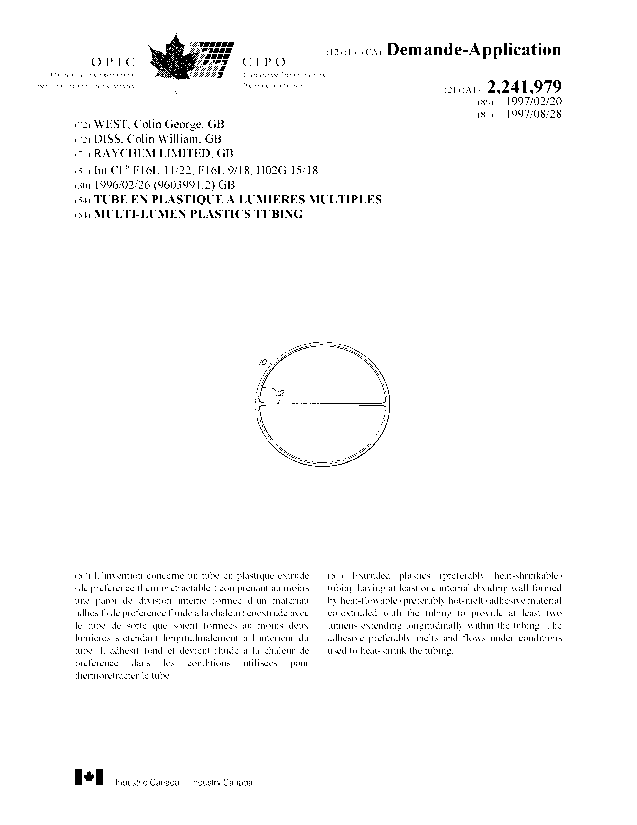Some of the information on this Web page has been provided by external sources. The Government of Canada is not responsible for the accuracy, reliability or currency of the information supplied by external sources. Users wishing to rely upon this information should consult directly with the source of the information. Content provided by external sources is not subject to official languages, privacy and accessibility requirements.
Any discrepancies in the text and image of the Claims and Abstract are due to differing posting times. Text of the Claims and Abstract are posted:
| (12) Patent Application: | (11) CA 2241979 |
|---|---|
| (54) English Title: | MULTI-LUMEN PLASTICS TUBING |
| (54) French Title: | TUBE EN PLASTIQUE A LUMIERES MULTIPLES |
| Status: | Deemed Abandoned and Beyond the Period of Reinstatement - Pending Response to Notice of Disregarded Communication |
| (51) International Patent Classification (IPC): |
|
|---|---|
| (72) Inventors : |
|
| (73) Owners : |
|
| (71) Applicants : |
|
| (74) Agent: | SMART & BIGGAR LP |
| (74) Associate agent: | |
| (45) Issued: | |
| (86) PCT Filing Date: | 1997-02-20 |
| (87) Open to Public Inspection: | 1997-08-28 |
| Availability of licence: | N/A |
| Dedicated to the Public: | N/A |
| (25) Language of filing: | English |
| Patent Cooperation Treaty (PCT): | Yes |
|---|---|
| (86) PCT Filing Number: | PCT/GB1997/000464 |
| (87) International Publication Number: | GB1997000464 |
| (85) National Entry: | 1998-07-02 |
| (30) Application Priority Data: | ||||||
|---|---|---|---|---|---|---|
|
Extruded plastics (preferably heat-shrinkable) tubing having at least one
internal dividing wall formed by heat-flowable (preferably hot-melt) adhesive
material co-extruded with the tubing to provide at least two lumens extending
longitudinally within the tubing. The adhesive preferably melts and flows
under conditions used to heat-shrink the tubing.
L'invention concerne un tube en plastique extrudé (de préférence thermorétractable ) comprenant au moins une paroi de division interne formée d'un matériau adhésif (de préférence fluide à la chaleur) coextrudé avec le tube de sorte que soient formées au moins deux lumières s'étendant longitudinalement à l'intérieur du tube. L'adhésif fond et devient fluide à la chaleur de préférence dans les conditions utilisées pour thermorétracter le tube.
Note: Claims are shown in the official language in which they were submitted.
Note: Descriptions are shown in the official language in which they were submitted.

2024-08-01:As part of the Next Generation Patents (NGP) transition, the Canadian Patents Database (CPD) now contains a more detailed Event History, which replicates the Event Log of our new back-office solution.
Please note that "Inactive:" events refers to events no longer in use in our new back-office solution.
For a clearer understanding of the status of the application/patent presented on this page, the site Disclaimer , as well as the definitions for Patent , Event History , Maintenance Fee and Payment History should be consulted.
| Description | Date |
|---|---|
| Inactive: IPC from MCD | 2006-03-12 |
| Inactive: IPC from MCD | 2006-03-12 |
| Application Not Reinstated by Deadline | 2003-02-20 |
| Deemed Abandoned - Failure to Respond to Maintenance Fee Notice | 2003-02-20 |
| Inactive: Dead - RFE never made | 2003-02-20 |
| Inactive: Abandon-RFE+Late fee unpaid-Correspondence sent | 2002-02-20 |
| Inactive: IPC assigned | 1998-10-29 |
| Inactive: IPC assigned | 1998-10-29 |
| Inactive: First IPC assigned | 1998-10-29 |
| Inactive: IPC assigned | 1998-10-29 |
| Classification Modified | 1998-10-29 |
| Inactive: Notice - National entry - No RFE | 1998-09-11 |
| Application Received - PCT | 1998-09-08 |
| Application Published (Open to Public Inspection) | 1997-08-28 |
| Abandonment Date | Reason | Reinstatement Date |
|---|---|---|
| 2003-02-20 |
The last payment was received on 2001-12-20
Note : If the full payment has not been received on or before the date indicated, a further fee may be required which may be one of the following
Patent fees are adjusted on the 1st of January every year. The amounts above are the current amounts if received by December 31 of the current year.
Please refer to the CIPO
Patent Fees
web page to see all current fee amounts.
| Fee Type | Anniversary Year | Due Date | Paid Date |
|---|---|---|---|
| Basic national fee - standard | 1998-07-02 | ||
| Registration of a document | 1998-07-02 | ||
| MF (application, 2nd anniv.) - standard | 02 | 1999-02-22 | 1999-01-15 |
| MF (application, 3rd anniv.) - standard | 03 | 2000-02-21 | 2000-01-18 |
| MF (application, 4th anniv.) - standard | 04 | 2001-02-20 | 2001-01-03 |
| MF (application, 5th anniv.) - standard | 05 | 2002-02-20 | 2001-12-20 |
Note: Records showing the ownership history in alphabetical order.
| Current Owners on Record |
|---|
| RAYCHEM LIMITED |
| Past Owners on Record |
|---|
| COLIN GEORGE WEST |
| COLIN WILLIAM DISS |